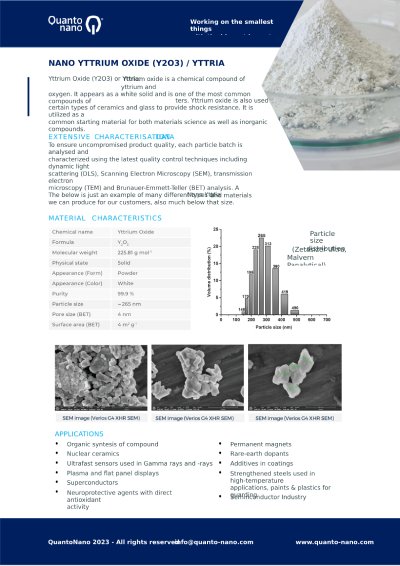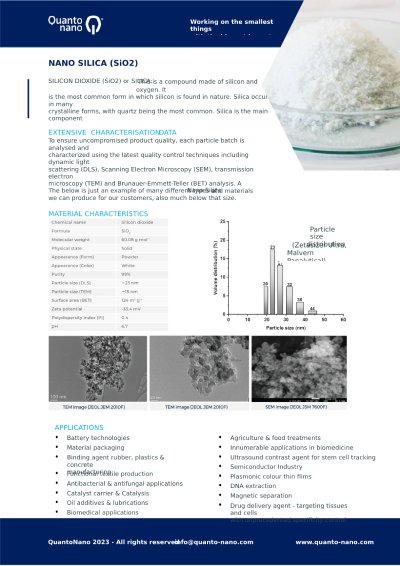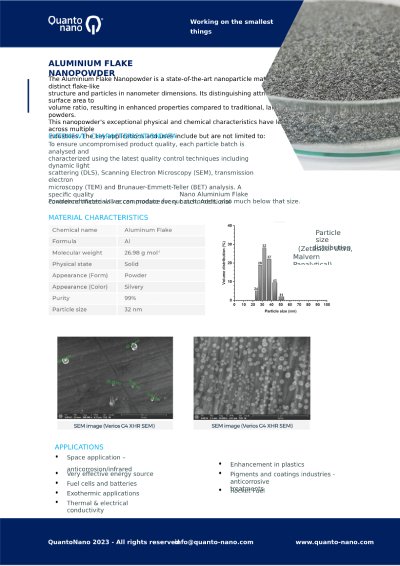Nano Materials
Nanostructured Coatings
Quanto Nano
Product Categories
Quanto Nano
Nanostructured Coatings
These coatings minimize glare and reflection on surfaces like lenses and solar panels. Nanostructured layers create a gradient in refractive index, enhancing light transmission and reducing reflection.
Send Inquiry
Applied to surfaces to repel water, these coatings are made of nanoparticles that create a micro-textured surface. They are used in waterproof clothing, anti-corrosion treatments, and self-cleaning surfaces.
Send Inquiry
These coatings are designed to protect components from extreme temperatures. Used in aerospace and automotive engines, they consist of materials like yttria-stabilized zirconia (YSZ) that provide thermal insulation.
Send Inquiry
These innovative coatings can repair themselves after damage. They contain microcapsules or nanocomposites that release healing agents when cracked, extending the life of the coated material.
Send Inquiry
Utilized to provide electrical conductivity to surfaces, these coatings are made of materials like silver or carbon nanotubes. They are used in electronics, antistatic materials, and electromagnetic shielding.
Send Inquiry
Used in healthcare and food packaging, these coatings incorporate silver, copper, and zinc oxide nanoparticles for their germicidal properties. They inhibit the growth of bacteria and fungi on surfaces, enhancing hygiene and safety.
Send Inquiry
Applied in outdoor materials and sunscreens, these coatings use titanium dioxide (TiO2) and zinc oxide (ZnO) nanoparticles. They provide protection against harmful ultraviolet radiation.
Send Inquiry
Employed in marine and industrial environments, these coatings use zinc oxide and graphene oxide to protect surfaces from corrosion, extending the life of metal structures and components.
Send Inquiry
Applied in self-cleaning surfaces and environmental remediation, these coatings utilize titanium dioxide (TiO2) nanoparticles. They break down organic pollutants under light, keeping surfaces clean and breaking down pollutants in the air.
Send Inquiry
Used on lenses and mirrors, these coatings often involve hydrophilic nanoparticles like silicon dioxide. They prevent the condensation of water in the form of tiny droplets, maintaining clear visibility.
Send Inquiry
Employed in smart windows and displays, these coatings use materials like tungsten oxide (WO3) and conducting polymers. They change color or opacity in response to electrical stimulation.
Send Inquiry
Used in data storage and magnetic sensors, these coatings employ iron oxide (Fe3O4) nanoparticles. They are crucial in the miniaturization and enhanced performance of magnetic devices.
Send Inquiry
Summary
Nanostructured coatings offer revolutionary functionalities across various industries, from enhancing optical properties with anti-reflective coatings to protecting against environmental factors with hydrophobic and corrosion-resistant layers. Their unique properties, such as self-healing, antimicrobial, and photocatalytic abilities, make them integral in advancing material technologies and improving the durability, safety, and performance of coated surfaces.

WE WORK ON THE SMALLEST THINGS WITH THE BIGGEST IMPACT











